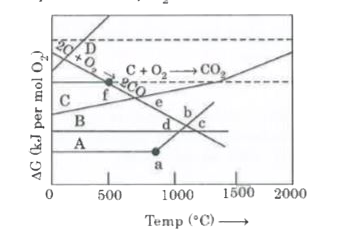Complete Solutions to Example of chapter GENERAL PRINCIPLES AND PROCESSES OF ISOLATION OF ELEMENTS of Class 12 book with complete answers and questions
| Class 12 | CHEMISTRY |
| Chapter | GENERAL PRINCIPLES AND PROCESSES OF ISOLATION OF ELEMENTS |
| MODERN PUBLICATION | Example |
| Number Of Questions | 14 |
| Academic Year | 2023-24 |
In general which metal do you expect to occur in the native state in nature? Give example.
View SolutionWhy do metal sulphides occur mainly in rocks and metal halides in lakes and seas?
View SolutionName two examples each of the following types of ores :
(a) Oxides (b) Sulphides (c) Carbonates (d) Silicates
View SolutionHow does sodium cyanide act as depressant in preventing `ZnS` from forming the froth ?
View SolutionWhat is flux ? How is it useful?
View SolutionOut of C and CO, which is better reducing agent for ZnO?
View SolutionA part of Ellingham diagram for some metal oxides (Based upon 1 mole of `O_2`) and carbon is shown.

In figure A,B,C and D represent curves for metal oxides and a,b,c,d ,e and f are temperatures. Answer the following :
(i) Will B oxide reduce metal oxide of A or C or both ?
(ii) Which metal can be reduced thermally ?
(iii) Will oxide of B be reduced by coke above temperature c or below temperature c ?
(iv) Will the formation of CO or `CO_2` be preferred above temperature f ?
(v) What does temperature 'a' represent ?
View SolutionCopper can be extracted by hydrometallurgy but not zinc. Explain.
View SolutionFree energies of formation `(Delta_(f) G^(Ө))` of `MgO(s)` and `CO_((g))` at `1273 K` and `2273 K` are given below :
`Delta_(f) G^(Ө) (MgO_((s) )) = -941 kJ//mol at 1273 K`
`Delta_(f) G^(Ө) (MeO_((s))) = -314 kJ//mol at 2273 K`
`Delta_(f) G^(Ө) (CO_((g))) = - 439 kJ//mol at at 1273 K`
`Delta_(f) G^(Ө) (CO_((g))) = -628 kJ//mol at 2273 K`
On the basis of above data, predict the temperature at which carbon can be used as a reducing for agent `MgO_((s))`.
View SolutionThe value of `Delta_f G^@` for the formation of `Cr_2 O_3` is `-540 KJ mol^(-1)` and that of `Al_2 O_3` is `-827 KJ mol^(-1)`. Is reduction of `Cr_2 O_3` possible with `Al` ?
View SolutionWhy is the reduction of a metal oxide easier if the metal formed is in liquid state at the temperature of reduction?
View SolutionAt a site, low grade copper ores are available and zinc and iron scraps are also available. Which of the two scraps would be more suitable for reducing the leached copper ore and why?
View Solution(a) Give one example each of the following:
(i) Acidic flux (ii) Basic flux
(b) What happens when
(i) `Cu_2 O` undergoes self reduction in a silica line converter.
(ii) Haematite oxidises carbon to carbon monoxide.
View SolutionAlthough thermodynamically feasible, in practice, magnesium metal is not used for the reduction of alumina in the metallurgy of aluminium. Why ?
View Solution
Example questions and complete solutions for chapter GENERAL PRINCIPLES AND PROCESSES OF ISOLATION OF ELEMENTS of MODERN PUBLISHERS CHEMISTRY (HINGLISH) of Class 12
All Exercises from MODERN PUBLICATION Class 12 CHEMISTRY GENERAL PRINCIPLES AND PROCESSES OF ISOLATION OF ELEMENTS
- COMPETION FILE (Integer Type Numerical Value Type Questions)
- COMPETION FILE (Matrix Match Type Questions)
- COMPETION FILE (Objective Questions) (Multiple Choice Question from competitive examinations)
- COMPETION FILE (Objective Questions) (Multiple Choice Question with more than one correct answers)
- COMPETION FILE (Objective Questions) (Multiple Choice Question with only one correct answer)
- Conceptual Questions
- Example
- HOTS (Higher Order Thinking skills) (Advanced Level)
- Memory Test (Choose the correct alternative)
- Memory Test (Complete the missing links)
- Memory Test (Say true or false)
- NCERT FILE (Ncert Exemplar Problems) (Assertion and Reason Type Questions)
- NCERT FILE (Ncert Exemplar Problems) (Matching Type Questions)
- NCERT FILE (Ncert Exemplar Problems) (Multiple Choice Questions (Type-I))
- NCERT FILE (Ncert Exemplar Problems) (Multiple Choice Questions (Type-II))
- NCERT FILE (Ncert Exemplar Problems) (Short Answer Type Questions)
- NCERT FILE (Ncert In-text Questions)
- NCERT FILE (Ncert Textbook Exercises)
- Revision Exercises(Assertion Reason Questions)
- Revision Exercises(CBSE Qs.)
- Revision Exercises(Multiple choice questions
- Revision Exercises(Multiple choice questions)
- Revision Exercises(One word/Short sentence Answer)
- Revision Exercises(Passage Based Questions)
- Revision Exercises(Short answer questions)